
User’s Manual of SGSD-1022 / SGSD-1022P
SGSW-2840 / SGSW-2840P
230
4.10.1.3 Queue Mode
Selecting the Queue Mode
You can set the Managed Switch to service the queues based on a strict rule that requires all traffic in a higher priority queue to
be processed before lower priority queues are serviced, or use Weighted Round-Robin (WRR) queuing that specifies a
relative weight of each queue, or a combination of strict service for the high priority queues and weighted queueing for the
remaining queues.
Command Usage
• Strict priority requires all traffic in a higher priority queue to be processed before lower priority queues are serviced.
• WRR uses a relative weighting for each queue which determines the amount of packets the switch transmits every time it
services each queue before moving on to the next queue. Thus, a queue weighted 8 will be allowed to transmit up to 8
packets, after which the next lower priority queue will be serviced according to it’s weighting. This prevents the head-of-line
blocking that can occur with strict priority queuing.
• Hybrid mode uses strict priority queuing for the highest priority queue (queue 3) processing queues 2 through 0 according to
their WRR weights.
Figure 4-10-3 Queue Mode page screenshot
The page includes the following fields:
Object Description
Strict
Services the egress queues in sequential order, transmitting all traffic in the
higher priority queues before servicing lower priority queues.
WRR
Weighted Round-Robin shares bandwidth at the egress ports by using
scheduling weights with default values of 1, 2, 4, 8 for queues 0 through 3,
respectively.
(This is the default selection.)
Hybrid
Services the highest priority queue (3) according to strict priority queuing, after
which the 3 lower priority queues (0, 1, 2) are processed according to their WRR
weightings.


















